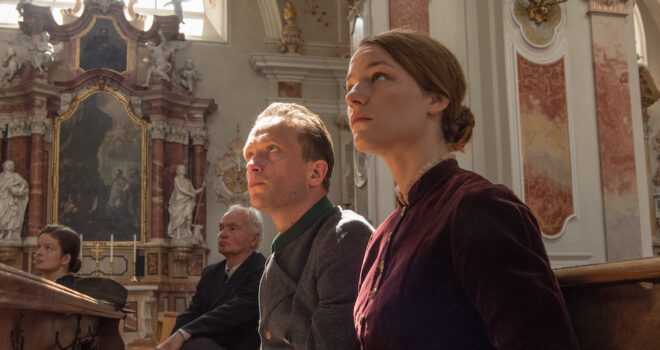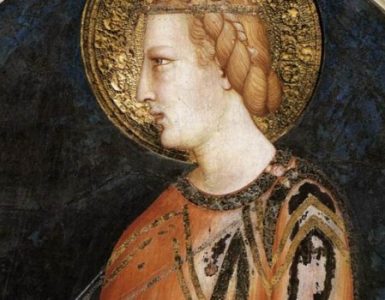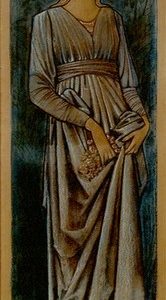For centuries people have used art during Holy Week to meditate on the mysteries of Christ’s passion and death. Great art complements the great liturgies of Holy Week and can itself be a kind of contemplation that draws us more deeply into the liturgical reality of Christ’s passion.
Film does not have to be passive popcorn entertainment or gritty antihero relativism. At its best, it can combine visual poetry, narrative and music to lift our minds and hearts to God.
Although these suggestions are not what you would call “Jesus movies,” all confront our own worldly egoism and immerse us into the mystery of Christ’s saving passion.
A Hidden Life (2019)
In 2007 Pope Benedict XVI beatified Franz Jägerstätter, the Austrian farmer who refused to sign an oath to Hitler. His life sounds ordinary, but Terrence Malick suffuses this spellbinding biopic with such supernatural awareness that there is a sacred quality even in the smallest moments. The film is also laden with scripture, especially from Jesus’s parables and passion.
In the beginning we watch Franz and Fanni farm and raise their daughters in an Edenic mountain village. They seem blissfully happy, but the opening music, Bach’s St Matthew’s Passion, hints where their lives will go. Franz is called up to serve in the army, which he soon leaves after refusing to sign the oath to Hitler. He prayerfully discerns this weighty decision and eventually is sent to prison where he prays, writes letters to his wife, and comforts other prisoners.
Franz’s passion is also his wife’s as she bears not only the heavy burdens of farming life and mothering alone, but suffers mockery and ostracization from her neighbors. Everyone besides Fanni, even the parish priest and bishop, pressure him to sign the oath and thus end his death sentence. However, Franz’s conscience tells him that it is better to suffer persecution than acquiesce with evil.
Ultimately it is Franz and Fanni’s shared faith and marriage that allow them to bear their cross. This film is a testament to the beauty of a marriage lived in light of a great love for Christ. Malick reminds us that we are called to follow Christ, not just admire him.
(Amazon Prime, Apple TV, Hulu)
The Dialogues of the Carmelites (1960)
George Bernanos, the great spiritual writer of the 20th century, wrote the text behind this spiritual drama about the Carmelite Martyrs of the French Revolution. The 1960 film is a lesser known gem, and the 2019 Met performance of Poulnec’s opera is magnificent. Beautiful hymns punctuate some of the most powerful parts of both the film and opera calling us to contemplation along with the sisters. The black and white cinematography complements the simple beauty of life in the cloister and gives poignant contrast to the dark insanity of the revolution.
In the narrative we follow an unlikely nun, the beautiful and aristocratic Blanche, who enters the convent and is torn between her vanity and her love for God. Though the film leaves out some of the more dense theological ideas from the opera, it includes many spiritual conversations between the sisters. They wrestle with questions about the nature of grace, providence, fear, and Christ’s sacrifice as they prepare for their persecution and death. Ultimately, God does not give them the lot they would choose for themselves but he gives them the grace to bear it.
In the haunting finale, the sisters ride to the guillotine in their habits singing the Salve Regina (Veni Creator Spiritus in the film). Because of these sisters, Parisians heard this hymn for the first time since the revolution started and overthrew Robespierre just ten days after the martyrdom. Their example reminds us of the gift of grace God gives us to bear our own crosses.
(YouTube, Rarefilms) (Opera available on Apple TV)
Calvary (2014)
Calvary gives us a glimpse into the life of a flawed but courageous priest ministering to a flock that despises him for no sin of his own. At the beginning of the film we hear that one of his parishioners is going to murder him in a week in revenge of a priest that abused him as a child. Fr. James lives this week knowing he may well be murdered at the end of it. He spends this time administering the sacraments and ministering to his parishioners who claim to hate him. Also, he prayerfully discerns how to care for the soul of the man who wants to kill him.
Fr. James is a priest who is socially engaged with his parishioners, but is not afraid to personally correct them in a spirit of charity. It is clear he cares more for their souls than about them liking him. His parishioners mock him with their sins and insults, yet he does not give up on trying to love them. To his people, the collar he wears is a sign of the depravity of the priests who sexually abused children. For Fr. James, wearing the collar is a sign of his faith and identification with Christ.
This film is heavy, but is ultimately redeemed by the example of the heroic priest whose example of forgiveness and love in the face of cruelty reminds us of the gift of redemption and forgiveness given to us by Christ.
(Amazon Prime, Apple TV, YouTube)
The Passion of Joan of Arc (1928)
Widely acclaimed as one of the best films of all time, this film is an enthralling portrait of the 15th century saint. The film centers on Joan’s trial and the narrative we get is scripted directly from the documents of the trial.
Joan’s responses to her captors’ questions are disarmingly honest and truthful; the English judges thought it would be easier to trick her. Nevertheless, she is steadfast, sorrowful, but serene; she is fixed on Christ and the cross. It is clear she has an intimacy with Him and that is what gives her the strength in the face of death. The high contrast camera lense enhances the visual flaws of Joan’s tormentors but exonerates her own innocence even more.
The film is almost entirely made up of closeups of faces, especially Joan’s face, the intensity of which is uncomfortable to watch but almost impossible to look away from. Renee Falconetti’s performance is considered to be the “finest performance ever on film” by many. Her eyes give us a window to the interior movements of a soul in a way almost no other film has since.
Joan endures much slander and derision, but she is most upset when her captors taunt her with the Eucharist. One of the most masterful and moving scenes is when she finally receives the Host with reverent bliss. The director, although agnostic, gives us such a window into Joan’s faith that this moment becomes the climax of the film. Shortly after this scene we witness the circus that surrounds her death and are reminded again of the parallels of her passion and Christ’s.
There are no grotesque displays of her suffering in this film. Her face and the image of the instruments of her torture are alone enough to inspire horror and compassion in us.
(Amazon Prime, Apple TV)
Rome, Open City (1945)
Rome Open City is the neorealist masterpiece featured on the Vatican film list by great Italian director Roberto Rossellini. Released only months after the Nazis left Rome, Rossellini presents a gritty portrait of the eternal city stripped of its magnificent grandeur under the occupation. The film gives a window into the individual lives of the Italian poor, highlighting a priest, an expecting couple, and a communist resistance fighter.
In the first half of the movie we follow many characters and are unsure of how the threads come together. Anna Magnani gives a famously tragic performance as the pregnant bride-to-be, but it is parish priest, Don Pietro, who ultimately carries this film to the end. We first see him comically trying to referee a soccer match with young boys and then ministering to an expecting couple who wishes to marry in the Church. His love gives life to the people of his parish in the midst of great tragedy as he bravely risks his life on their behalf and cares for their souls. As time goes on it becomes more apparent that this seemingly ordinary parish priest possesses a heroic virtue that is inspired by his faith in Christ and love for his flock. It is his martyrdom that inspires hope for the next generation and reminds us of the victory of the cross. Don Pietro is the rock of the film and the rock of faith for his flock.
(Amazon Prime, Apple TV)
Image: Still from A Hidden Life, Fox Searchlight Pictures










